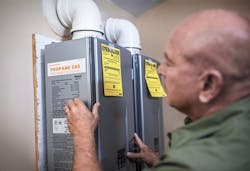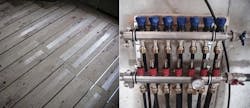Guest Column: Understanding Propane's Potential for Efficiency
Homeowner and homebuyer priorities are shifting. Today, more residential customers are seeking high-performance homes with lower energy costs and less environmental impact.
Because clients often turn to construction professionals to help them select the right energy systems for their homes, it’s important to be well versed in a variety of climate-friendly, cost-saving solutions, including propane.
High-efficiency Propane Systems Reduce Annual Energy Costs
Propane provides your clients the ability to choose first-rate amenities regardless of where they live. It powers everything from space and water heating to stoves and clothes dryers, offering a whole-home energy upgrade that delivers arguably superior comfort and efficiency compared with all-electric homes.
Analysis from an independent, third-party research firm found that propane homes can achieve significant energy consumption savings over the standard home on the Home Energy Rating System (HERS) Index. The analysis was based on modeling for two identical homes—one built with standard appliances and systems, and one built with a 95%-efficient propane furnace, a 0.95 Energy Factor propane tankless water heater, and Energy Star propane kitchen and laundry appliances.
Propane appliances can achieve efficiency levels over their electric counterparts.
Water heaters, for example, are one of the most energy intensive appliances in a home. A high-efficiency propane tankless water heater can be up to 34% more energy efficient than conventional storage tank models in homes that have moderate hot-water use, according to data from the Propane Education & Research Council (PERC). That’s a savings of roughly $150 to $200 per year compared with electric storage tank water models.
High-performance propane water heaters utilize a condensing design, extracting additional thermal energy from combustion gases to pre-heat incoming water, which increases overall system efficiency. Plus, these systems can qualify for credits and rebates both in new construction and as replacements to existing systems—making them even more cost effective.
Propane furnaces are another example. They offer best-in-class efficiency, with ratings from 90% to 98%, and will provide balanced, consistent heat during even the coldest weather. Propane-powered boilers offer efficiency, space savings, and the versatility to provide space heating, water heating, and even snow melt. In the coldest, outdoor climates where a dual-fuel hybrid system is used, propane can improve the efficiency and comfort of air-or ground-source heat pump systems and further protects homeowners from rising utility costs.
Propane Reduces a Home’s Carbon Footprint
Because propane produces 43% fewer greenhouse gas emissions than using an equivalent amount of electricity generated from the grid, according to PERC data, a typical electric storage tank water heater can have emissions two-and-a-half times higher than those of a propane tankless system.
Propane-powered residential storage tank water heaters can emit up to 56% fewer greenhouse gas emissions than electric-powered water heaters and produce nearly 20% fewer greenhouse gas emissions and 80% fewer nitrogen oxide (NOx) emissions than fuel oil water heaters.
Examples of in-floor hydronic radiant tubing (left) and a distribution manifold (right).
Caption and image: PERC
A high-efficiency propane boiler can result in significant CO2 emission reductions compared with a heating oil boiler, according to PERC data. Even for propane and heating oil boilers of comparable efficiency levels, a heating systems analysis conducted by PERC determined that the CO2 emissions from a high-efficiency propane boiler were 2,749 pounds (~1.4 tons) lower per year than for a high-efficiency oil boiler for a Northeast home. In that same analysis, the CO2 emissions for a propane boiler-fed in-floor hydronic system were lower when compared with several other furnace and heat pump systems in the Midwest.
In the kitchen, propane-powered cooking ranges can generate up to 15% fewer site-to-source greenhouse gas emissions and 83% fewer sulfur oxide (SOx) emissions compared to electric ranges. Propane cooktops allows for greater temperature control than electric ranges; fluctuating cooking surface temperatures can have an effect on the amount of emissions a stovetop generates during cooking.
Propane is already powering more than 12 million homes with reliable energy they can count on for lower energy costs and a smaller environmental footprint. Customer demand for clean, efficient new homes continues to rise. When customers turn to you for guidance, make sure you’re well versed on all high-performance options.
Bryan Cordill is the director of residential business development at the Propane Education & Research Council. He can be reached at [email protected].

